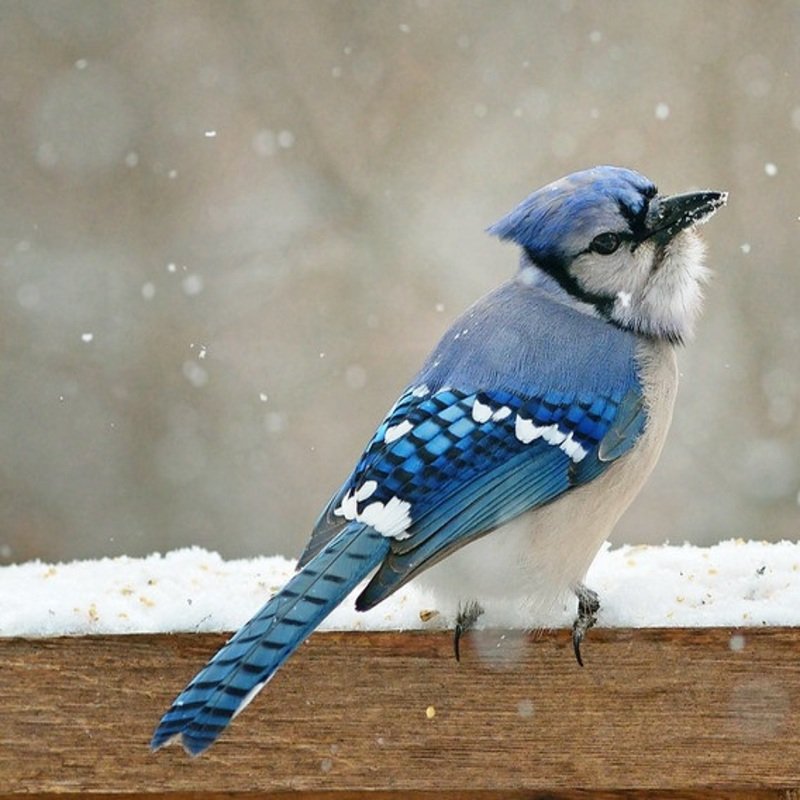The blue jay, Cyanocitta cristata is a passerine bird of the Corvidae family that is indigenous to eastern North America. It is found across the eastern and central United States; certain populations in the east may be migratory. The term “jay” refers to the bird’s boisterous, garrulous personality and has been applied to other members of the same family that are equally sociable.
Quick Overview: Cyanocitta Cristata – Blue Jay
Body size: Around 11 in (28 cm) and a weight of 85 g (3 oz)
Main colors: Blue, Gray, Gray-Blue, Black
Range: Eastern United States
Migratory Bird: Yes
Best time of the year to see in the U.S.: All Year (January – December)
Conservation Status: Least Concern
Blue Jay Description
Blue jays have a brilliant blue head and a pale gray abdomen and chin. They have a feather crested gray-blue head that they can rise and descend. Their wings and tails have vivid blue feathers with white and black stripes. Additionally, blue jays have a collar of black feathers that runs around the throat and around the head. Their bills, legs, and feet are all black, as are their eyes. Males are somewhat bigger than females on average.

Size
These birds have a length of 11 in (28 cm) and a weight of 85 g (3 oz). Their wings could range from 16 in (41 cm).
Feeding
Blue jays eat a variety of foods. They eat fruits, nuts, seeds, insects, mice, and frogs and will raid neighboring nests in search of tiny songbirds and bird eggs. Blue jays consume nuts by first grasping them with their foot and then cracking the shell with their beak. Blue jays kept in captivity have been observed to create gadgets to obtain food. Additionally, blue jays will steal food from other birds by scaring them into abandoning their prey. They store items, like as seeds, for future consumption.
Habitat
Blue jays are like mixed forests with clearings. Additionally, they are prevalent in suburban regions and municipal parks.
Behavior
Blue jays are highly aggressive and loud birds that aggressively pursue other birds away from food sources and territory. Blue jays conceal significantly more food than they can consume throughout the winter, maybe to deter intruders by removing food from their areas. They are also somewhat migratory, and in the fall, groups of more than a hundred birds may be observed migrating together.
Cyanocitta Cristata Scientific Classification
- Kingdom: Animalia
- Phylum: Chordata
- Subphylum: Chelicerata
- Class: Aves
- Order: Passeriformes
- Family: Corvidae
- Genus: Cyanocitta
- Species: Cyanocitta cristata
Best time of the year to see
In the United States, the best time of year to see these birds is all year round, regardless of the season. This refers to any month of the year between January and December.
Distribution of the Blue Jay in the USA
East of the Rockies Maine, New Hampshire, Massachusetts, Rhode Island, Connecticut, New York, North Carolina, Georgia, and South Carolina, from southern Canada to the Gulf of Mexico, this species is a resident but is progressively moving westward. Breeds all the way up to central Canada. During the winter, it is possible to go to the Pacific Northwest.
The Blue Jay can be found in the following states in the United States – Alabama, Alaska, Arkansas, Colorado, Delaware, Florida, Hawaii, Illinois, Indiana, Iowa, Kansas, Kentucky, Louisiana, Maryland, Michigan, Minnesota, Mississippi, Missouri, Nebraska, New Jersey, North Dakota, Ohio, Oklahoma, Pennsylvania, South Dakota, Tennessee, Utah, Vermont, Virginia, West Virginia, Wisconsin, and Wyoming.
